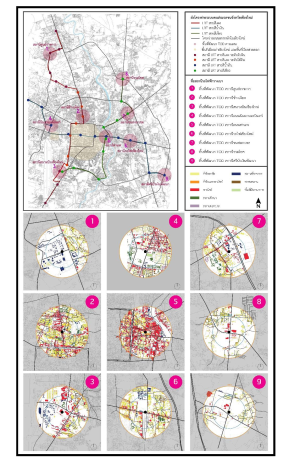A Study of TOD Indicators Affecting the Urban Quality: Case Study of Chiang Mai Light Rail Transit Project
DOI:
https://doi.org/10.14456/psruhss.2024.24Keywords:
Transit-oriented development (TOD), Chiang mai light rail transit, Urban sustainable developmentAbstract
The rapid growth of urban area and economy of Chiang Mai (Urbanization) directly affect the urban quality such as traffic congestion and air pollution. In attempt to fix the above problem. Therefore, the Chiang Mai light rail project was established. Which has adopted the concept of Transit-Oriented Development (TOD) was used to develop projects for Chiang Mai to grow in accordance with the development of the country. This article has two objectives: 1) To study the TOD Indicators under the context of Chiang Mai City; by studying and reviewing the literature and take lessons from successful practices 2) to select TOD indicators of areas surrounding the Chiang Mai. Mass transit station. Through surveying the areas surrounding the light rail stations in 9 areas and synthesizing factors suitable for urban quality development within the context of Chiang Mai. The results of the study obtained 15 indicators from 3 aspects from the concept of urban sustainable development (Urban Sustainable Development) are 1) social and Cultural aspects, 2) physical and Environmental aspects, and 3) economic aspects, which is information for the strategy development and appropriate urban planning.
References
การรถไฟฟ้าขนส่งมวลชนแห่งประเทศไทย (2562). รายงานความก้าวหน้าเดือนที่ 6 (Progress Report No.6) โครงการศึกษารายละเอียดความเหมาะสม ออกแบบเเละจัดเตรียมเอกสารประกวดราคา โครงการระบบขนส่งจังหวัดเชียงใหม่ สายสีเเดง (โรงพยาบาลนครพิงค์ - เเยกเเม่เหียะสมานสามัคคี). กรุงเทพฯ: การรถไฟฟ้าขนส่งมวลชนแห่งประเทศไทย (รฟม.).
พนิต ภู่จินดา, และยศพล บุญสม. (2559). แนวคิดการพัฒนาเมืองต้นแบบ. เจ-ดี : วารสารวิชาการ การออกแบบสภาพแวดล้อม, 3(1), 21-43.
มนสิชา เพชรานนท์. (2561). การวิเคราะห์ศักยภาพเชิงพื้นที่เพื่อการพัฒนา TOD เมืองขอนแก่น. วารสารสิ่งแวดล้อมสรรค์สร้างวินิจฉัย คณะสถาปัตยกรรมศาสตร์ มหาวิทยาลัยขอนแก่น, 17(2), 93-113.
อัมพิกา ชุมมัธยา, และณวิทย์ อ่องแสวงชัย. (2561). การขยายตัวของเมืองกับการเปลี่ยนแปลงบริบทของย่านเมืองเก่าในจังหวัดเชียงใหม่. เจ-ดี: วารสารวิชาการ การออกแบบสภาพแวดล้อม, 5(1), 61-81.
Bertolini, L. (1999). Spatial development patterns and public transport: The application of an analytical model in the Netherlands. Planning Practice and Research, 14(2), 199-210.
Calthorpe Associates. (1990). Transit-oriented development design guidelines. California : Author.
Center for Transit-Oriented Development. (2011). Transit-oriented development strategic plan for metro TOD program. Portland, Oregon.
Center for Transit-Oriented Development. (2013). Transit-oriented development typology strategy for Allegheny county. Pittsburgh, Pennsylvania.
Chorus, P., & Bertolini, L. (2011). An application of the node place model to explore the spatial development dynamics of station areas in Tokyo. The Journal of Transport and Land Use, 4(1), 45-58.
Huang, R., Grigolon, A., Madureira, A. M., & Brussel, M. (2018). Measuring transit-oriented development (TOD) network complementarity based on TOD node typology. Journal of Transport and Land Use, 11(1), 304-324.
Ivan, I., Boruta, T., & Horak, J. (2012). Evaluation of railway surrounding areas: the case of Ostrava city. WIT Transactions on The Built Environment, 128, 141-152.
Kamruzzaman, M., Baker, D., Washington, S., & Turrell, G. (2014). Advance transit oriented development typology: case study in Brisbane, Australia. Journal of Transport Geography, 34, 54-70.
Li, Z., Han, Z., Xin, J., Luo, X., Su, S., & Weng, M. (2019). Transit oriented development among metro station areas in Shanghai, China: Variations, typology, optimization and implications for land use planning. Land Use Policy, 82, 269-282.
Liu, Y., Singleton, A., & Arribas-Bel, D. (2020). Considering context and dynamics: A classification of transit-orientated development for New York City. Journal of Transport Geography, 85, 102711.
Lyu, G., Bertolini, L., & Pfeffer, K. (2016). Developing a TOD typology for Beijing metro station areas. The Journal of Transport Geography 55, 40-50.
Monajem, S., & Nosratian, F. E. (2015). The evaluation of the spatial integration of station areas via the node place model; an application to subway station areas in Tehran. Transportation Research Part D, 40, 14-27.
Ratner, K. A., & Goetz, A. R. (2013). The reshaping of land use and urban form in Denver through transit-oriented development. Cities, 30, 31-46.
Shastry, S. (2010, August). Spatial assessment of transit oriented development in Ahmedabad, India (Master's thesis). Retrieved January 13, 2022 from: https://essay.utwente.nl/59707/
Singh, Y. J., Fard, P., Zuidgeest, M., Brussel, M., & Maarseveen, M. V. (2014). Measuring transit oriented development: a spatial multi criteria assessment approach for the City Region Arnhem and Nijmegen. Journal of Transport Geography, 35, 130-143.
Su, S., Zhang, H., Wang, M., Weng, M., & Kang, M. (2021). Transit-oriented development (TOD) typologies around metro station areas in urban China: A comparative analysis of five typical megacities for planning implications. Journal of Transport Geography, 90, 102939.
Taki, H. M., & Maatouk, M. M. (2018). Promoting transit oriented development typology in the transportation planning. Communications in Science and Technology, 3(2), 64-70.
Teklemariam, E. A., & Shen, Z. (2020). Determining transit nodes for potential transit-oriented development: Along the LRT corridor in Addis Ababa, Ethiopia. Frontier of Architectural Research, 9, 606-622.
United Nations. (2015). The 17 Goals. Retrieved September 15, 2020: https://sdgs.un.org/goals
Vale, D. S. (2015). Transit-oriented development, integration of land use and transport, and pedestrian accessibility: Combining node-place model with pedestrian shed ratio to evaluate and classify station areas in Lisbon. Journal of Transport Geography, 45, 70-80.
Zemp, S., Stauffacher, M., Lang, D. J., & Scholz, R. W. (2011). Classifying railway stations for strategic transport and land use planning: Context matters!. Journal of Transport Geography, 19, 670-679.

Downloads
Published
How to Cite
Issue
Section
License
Copyright (c) 2024 Humanities and Social Sciences Journal of Pibulsongkram Rajabhat University

This work is licensed under a Creative Commons Attribution-NonCommercial-NoDerivatives 4.0 International License.
Any articles or comments appearing in the Journal of Humanities and Social Sciences, Rajabhat Phibulsongkram University, are the intellectual property of the authors, and do not necessarily reflect the views of the editorial board. Published articles are copyrighted by the Journal of Humanities and Social Sciences, Rajabhat Phibulsongkram University.








